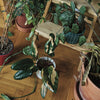Peat rod for all straining maids

Most houseplants come from tropical areas, where they have a habit of twining and climbing up various supports and trees towards the sun. Even though at first glance it may not seem that the plants are suffering intensively in the indoor conditions here, the truth is that some of them can really miss climbing. So why is it worth buying a support for some maids - either a coconut or a peat stick ? And which one to choose? You will learn all this in this article.
The higher the bigger!
So what do houseplants likemonsteras , philodendrons, syngonia or epipremna (and many other climbers) miss the most? Well, the mentioned plants form so-called aerial roots, with which they attach themselves to trees and natural supports in natural conditions. Thanks to the support, they can grow taller and stronger. Their leaves get bigger, which can take in more sunlight, and the plant generally thrives.
Who wouldn't be tempted by leaves as big as a hand… what about a hand, a whole head? The dream of every passionate maid is to have beautiful, large and above all healthy maids. With a stick or a flower , this not-so-modest wish is a little closer to being fulfilled!
The higher the hole!
"The more stripes, the more...", but you know. But it can be similar for maids. The higher the plant grows or climbs and the more sun it gets, the more it will form the popular fenestration - leaf perforations. We know this phenomenon especially in monsters, whose leaky leaves are so typical of them! Fenestrations are also capable of other types of plants, but they usually only occur in natural conditions, which are difficult to create at home.
Providing support for houseplants really benefits and their growers will also be pleased with the many benefits. But how to choose the right support?
In general, the supports have one more benefit, which is more from the side of the growers. If the plant grows tall (for example around a support), it saves a lot of space for other plants - and that pays off, right?
Coconut or peat moss?
The two best-known types of supports are coconut or peat sticks. We just stick such sticks into the substrate near the plant (watch out for the roots!), lightly attach the shoots or stems to it with, for example, string and we're done! But on what basis to decide which of the bars to buy?
Coconut bars
It is a wooden stick that is wrapped in coconut fiber. Such a rod has a solid structure, which is compact and a really good support especially for lianas - and therefore in general for the Aroid species - monstera, philodendron or pothos. The aerial roots of these plants cling to the fibrous structure of the pole and grow cheerfully upwards. In general, it is recommended to lower the coconut stick to the plant so that it holds as well as possible in the substrate!

Photo: To prepare a peat stick, you will need a peat stick itself, peat moss, a selected plant and a sufficiently large pot.
Peat sticks
We have already detailed the many benefits of sphagnum in an earlier article, but we will come back to them again. The ability of sphagnum lies primarily in its ability to retain water . The rod, which is made of living or compressed peat, thus enables not only support, but also the growth of new roots. In this way, the plant can grow through the pole with its roots and gain a much more stable position, in addition, the peat increases the humidity, which the plants will certainly appreciate. One of the other abilities of sphagnum is its resistance to rot . Peat stick, unlike coconut stick, needs to be watered more often and kept moist in order to meet all the benefits we have mentioned here. It is therefore slightly more demanding to maintain than a coconut stick.
So which one to choose? It's entirely up to you! Both poles have a lot to offer and the plants are sure to please their company. Coconut bars are mainly strong and are also sold in versions higher than a meter. It will certainly fit better with a large monster, as it will provide sufficient support. On the contrary, for example, philodendrons will certainly appreciate a more acidic peatland, which is, among other things, a source of various nutrients. Peat sticks are harder to find and are rather used in shorter versions. Fortunately, it is not that difficult to make them, even at home!
Production of a peat stick
In this article, we have also prepared instructions on how you can make a peat stick at home. All you will need to make are the individual parts of our adjustable rod and a peat moss - and of course the maid you want to gift the rod to!
Note: Adding a pole to a roommate is most worthwhile when the plant needs repotting. So when else to make and buy poles, if not in the spring ? Learn more about spring and transplanting in our other articles!
Preparation of peat
First of all, we pour water into a bowl or container, into which we gradually add compressed peat in small portions. After a few minutes, the sphagnum demonstrates its absorption capabilities and absorbs water. We can gently squeeze the excess water out of it.

Preparing the rod
While the sphagnum absorbs water, we prepare the required number of adjustable rod parts according to how much support we need. We screw the piercing tip to the first part of the rod and fill it with wet peat. Subsequently, we screw in other parts, which we also fill with peat.

Placing the rod in the substrate
It is advisable to place the sticking tip of the rod as deep as possible in the flower pot and firmly fix it with substrate all around so that it is stable and does not tip over. Along with the rod, we also plant the plant in the substrate. Think in advance how you will take it down to the pole - i.e. which side you want it to be attached to the pole.

Attaching the plant
When we have both the rod and the houseplant in the substrate, we can start tying the individual tendrils and stems to the rod. You can use wire, gardening tape or ordinary string. Be careful not to pull the plant's stems too much - you could damage it.

Installing the sprinkler head
One of the great benefits of our adjustable pole is the watering head that takes care of wetting the peat moss for you. You screw the head onto the end of the rod and fill it with water. There is a small hole inside, through which water drips to the peat and gradually moistens it. Once in a while you only need to refill the water head, but you don't have to worry about anything else!

Top dressing
In addition to the end of the rod from above, the add-on round head also fulfills another function. At the bottom of the head there is a roughly 0.5 mm hole through which water seeps through. When moistening the rod, you can pour water into the head and it will gradually seep from the top down into the peat. You can also moisten the rod by misting it over the entire width of the rod.

And just enjoy and wait for the miracles!
Well, you're done! The maid is happy to have support, you are happy to have a happy maid. What more could you wish for - LET IT GROW!
Bc. Jana Beránková
-
Posted in
Zajímavosti a tipy




